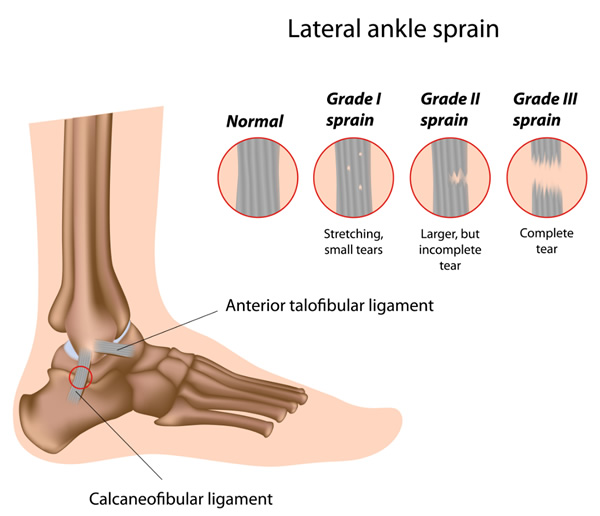
Ankle Injuries and Treatment
In general, ankle injuries can be instantaneous as caused by either a major traumatic accident (auto wreck) or a minor event(slipping or tripping). Ankle injuries are also a common instantaneous traumatic event in all different types of sports. Ill-fitting shoes such as clogs, or persistent wear of high-heeled shoes can cause injury to ankles over time and become a chronic condition.
Unlike foot injuries that are generally described by location, ankle injuries are described by the tissue that is injured; namely bone, tendons (attach muscle to bone) or ligaments (join bone to bone).
Fractures: There are three bones that make up the joint known as the ankle: two (tibia and fibula) are lower leg bones and the talus is within the foot. Any bone fracture is the result of a traumatic event, and the bones of the foot are no different. However, because of the weight bearing nature of this joint, events that may not normally be classified as “traumatic” can be enough to cause fracture of one or more of the bones comprising this joint.
Characteristically, the symptoms of fracture include sudden and severe pain and swelling accompanied by an inability to put weight on the joint plus bruising over time.
Diagnosis including x-rays and/or scans by a trained specialist is the key to providing treatment to restore your full range of ankle use.
Sprains: Sprains occur when ligaments holding the ankle bones together are stretched beyond their normal limits. The stretching can be minor or a complete rupture of the ligament that will require a surgical repair.
Symptoms for sprains are very similar to those of fractures which makes expedient professional diagnosis important in the long term success of treatment.
Strains: The two tendons that stabilize the ankle are most often involved in strains. As with sprains, stretching beyond the normal range of motion is involved, and can be immediate (due to trauma) or occur over time (due to overuse).
Tendon inflammation is called “tendonitis”. With both tendonitis and acute tears of the tendons, there is pain and swelling. Additionally, tendonitis presents an area that is warm to the touch. Tendonitis can result from a repeated insult to the ankle over the years and be felt as ankle weakness, instability and/or pain.
Subluxation is a tendon injury where the tendon slips out of place and the ankle feels noticeably unstable and weaker. Pain on the outside of the ankle is also common as is a “clicking” feeling within the ankle bone.
Treatment of Ankle Pain: Of course, the treatment is dependent upon the diagnosis…and the differential diagnosis should be made as quickly as possible by a trained foot care professional.
The treatment of all of the above will involve rest, i.e.., removal of weight from the ankle for an extended period of time. Correct application of ice within the first 48 hours of the injury and then proper compression to immobilize the ankle are important to control swelling and prevent further damage. Elevation of the affected ankle to heart level will further reduce swelling and consequently help to minimize pain.
Definitive treatment is then up to your foot care professional. In case of minor sprains or strains, continued immobilization, anti-inflammatory medication and rest may be all that is indicated. But, with fractures and tears, the severity of the injury may dictate a surgical necessity to restore normal function. The quicker you avail yourself of a professional diagnosis, the sooner you will be on your feet again! Give us a Call NOW!
You must be logged in to post a comment.